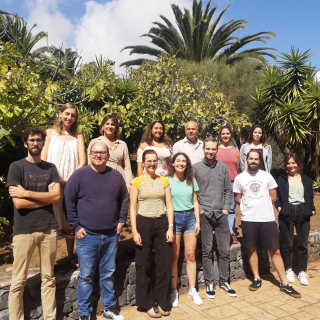Bibcode
Scott, Nicholas; Cappellari, Michele; Davies, Roger L.; Bacon, R.; de Zeeuw, P. T.; Emsellem, Eric; Falcón-Barroso, Jésus; Krajnović, Davor; Kuntschner, Harald; McDermid, Richard M.; Peletier, Reynier F.; Pipino, Antonio; Sarzi, Marc; van den Bosch, Remco C. E.; van de Ven, Glenn; van Scherpenzeel, Eveline
Bibliographical reference
Monthly Notices of the Royal Astronomical Society, Volume 398, Issue 4, pp. 1835-1857.
Advertised on:
10
2009
Citations
82
Refereed citations
76
Description
We present the results of an investigation of the local escape velocity
(Vesc) - line strength index relationship for 48 early-type
galaxies from the SAURON sample, the first such study based on a large
sample of galaxies with both detailed integral field observations and
extensive dynamical modelling. Values of Vesc are computed
using multi-Gaussian expansion (MGE) photometric fitting and
axisymmetric, anisotropic Jeans' dynamical modelling simultaneously on
Hubble Space Telescope and ground-based images. We determine line
strengths and escape velocities at multiple radii within each galaxy,
allowing an investigation of the correlation within individual galaxies
as well as amongst galaxies. We find a tight correlation between
Vesc and the line-strength indices. For Mgb, we find that
this correlation exists not only between different galaxies but also
inside individual galaxies - it is both a local and global correlation.
The Mgb-Vesc relation has the form: log(Mgb/4Å) = (0.32
+/- 0.03) log(Vesc/500km s-1) - (0.031 +/- 0.007)
with an rms scatter σ = 0.033. The relation within individual
galaxies has the same slope and offset as the global relation to a good
level of agreement, though there is significant intrinsic scatter in the
local gradients. We transform our line strength index measurements to
the single stellar population (SSP) equivalent ages (t), metallicity
([Z/H]) and enhancement ([α/Fe]) and carry out a principal
component analysis of our SSP and Vesc data. We find that in
this four-dimensional parameter space the galaxies in our sample are to
a good approximation confined to a plane, given by log (V
esc/500 kms -1) = 0.85 [Z/H] + 0.43 log (t/Gyr) -
0.29. It is surprising that a combination of age and metallicity is
conserved; this may indicate a `conspiracy' between age and metallicity
or a weakness in the SSP models. How the connection between stellar
populations and the gravitational potential, both locally and globally,
is preserved as galaxies assemble hierarchically may provide an
important constraint on modelling.
Related projects

Traces of Galaxy Formation: Stellar populations, Dynamics and Morphology
We are a large, diverse, and very active research group aiming to provide a comprehensive picture for the formation of galaxies in the Universe. Rooted in detailed stellar population analysis, we are constantly exploring and developing new tools and ideas to understand how galaxies came to be what we now observe.
Anna
Ferré Mateu